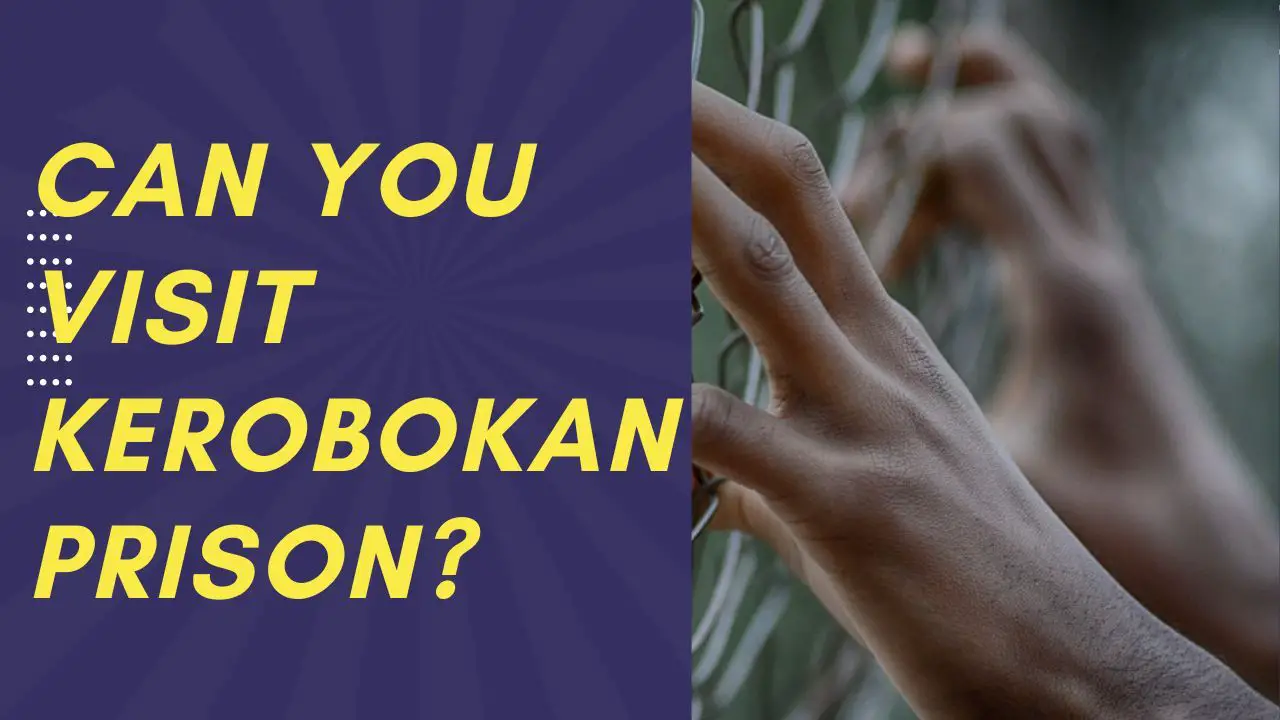Can You Visit Kerobokan Prison?
Can You Visit Kerobokan Prison? In this article, we have everything you need to know about Kerobokan Prison considered to be Bali’s most notorious prison.

Kerobokan Prison is considered to be Bali’s most notorious prison. If you’ve managed to survive Kerobokan, you’ve got plenty of reason to pride yourself in. The prison is a lawless facility, there is no crime you could name that doesn't go on in there. Many books have been written by the survivors of Kerobokan, detailing life inside this facility. Each of these accounts brings forth harrowing stories about the lives hidden inside the prison walls.
If you have been considering going to meet a loved one held at Kerobokan, you might be having reservations as to whether it is even allowed and if it is a good idea at all. For all the information you might need on Kerobokan, from its history to visiting terms, this article has got you covered.
Below is a detailed picture of Kerobokan Prison to answer all your questions.
Kerobokan Prison
Kerobokan Penitentiary Institution also known as Kerobokan Prison or LP Kerobokan which is short for Lembaga Pemasyarakatan Kerobokan, the prison’s name in Indonesian. Colloquially, it is referred to as Hotel K. The prison is located in Kerobokan, North Kuta District, Badung Regency, on the Indonesian island of Bali. It is located 4 km (2.49 miles) away from the Canggu village. Kerobokan Prison opened in 1979 and was built to house 300 prisoners. As of a report submitted in 2017, the Kerobokan Prison contains over 1,400 male and female inmates of various nationalities. More than 90% of the inmates are Indonesian and 78% of the prisoners were convicted on drug charges. 15,000 IDR (Indonesian Rupiah), an equivalent of $1.08 per day is allocated for each prisoner.
Notable Stories
- Schapelle Leigh Corby is an Australian woman who was convicted of smuggling cannabis into Indonesia and spent nine years imprisoned in Kerobokan Prison. Her case was broadcasted on live television and made headlines until her trial was over. On 27th May 2005, Corby was found guilty and sentenced to 20 years in jail, her sentence was later reduced after her pleas. She was also fined 100,000,000 IDR, an equivalent of about A$12,663.
- Bali Nine was a group of nine Australians convicted for attempting to smuggle 8.3 kg (18 lb) of heroin out of Indonesia in April 2005. The heroin, bound for Australia, was valued at around A$4 million. Ringleaders of the group Andrew Chan and Myuran Sukumaran were both sentenced to death. They were executed on 29th April 2015. Six other members named Si Yi Chen, Tan Duc Thanh Nguyen, Michael Czugaj, Matthew Norman, Martin Stephens, and Scott Rush were sentenced to life imprisonment. Another member called Renae Lawrence was given a 20-year sentence but was released after the sentence was commuted in November 2018. The Indonesian authorities reported on 5th June 2018 that one of the Bali Nine, Tan Duc Thanh Nguyen had died of stomach cancer.
- Michaël Loïc Blanc is a French national who was convicted of drug trafficking in Indonesia after 3.8 kilograms of hashish was found in his diving gear in December 1999. He was given a life sentence in Kerobokan prison but was later moved to Cipinang prison, Jakarta where he served 14 years before receiving parole on 20th January 2014. He subsequently moved back to France in 2018.
- Lindsay June Sandiford is a former legal secretary and convicted drug smuggler from North Yorkshire, England who was sentenced to death in January 2013 by an Indonesian court after being found guilty of smuggling cocaine into Bali. She is incarcerated on death row at Kerobokan Prison.
Inside the Kerobokan Prison
Kerobokan Prison has a long history of riots and violence involving both prisoners and guards. In December 2015, two prisoners were killed because of a riot between rival gangs, this led to police transferring more than one hundred inmates to other local prisons.
To some visitors, Kerobokan may seem like a cheap hotel. Prisoners spend hours roaming around the facility, some inmates even pay to decorate their cells, and they bribe guards for certain privileges.
However, there is more to Kerobokan than that. According to a recount by author Kathryn Bonella in her book Hotel K: The Shocking Inside Story of Bali's Most Notorious Jail, Schapelle Corby barely reacted when she found an inmate hanging by a noose. The Bali Nine’s Scott Rush helped guards drag a body covered in vomit and flies from the cell across the path from his cell.
In Kerobokan, murders are made to look like suicides. From “wild sex nights” to blocked toilets, Kerobokan houses all.
Some inmates have to sleep on hard tiled or concrete floors in 100-degree heat and as many as 40 to 50 inmates are forced to sleep together in a single room with blankets, pillows, and mosquito nets provided by charities.
As for the food, prisoners get two pieces of stale bread, two eggs, and a small number of greens each day. They must rely on charities for protein nourishment.
Escapes from Kerobokan Prison
On 19th June 2017, four foreign prisoners, an Australian Shaun Davidson, a Bulgarian Dimitar Nikolov Iliev, an Indian Saye Mohammed Said, and a Malaysian Tee Kok King escaped from the facility via a hole dug under a wall. The tunnel was 50 cm by 75 cm wide and 15 meters in length.
Similarly, on 10th December 2017, two American prisoners named Chrishan Beasley, 32, and Paul Anthony Hoffman, 57 escaped, allegedly using a ladder to climb the prison wall. These reports, however, are not confirmed, as others state the two had managed to cut a hole in the roof with the help of a hacksaw before escaping. Hoffman was caught "immediately" as reported by authorities, while Beasley was able to get away. A manhunt was initiated following his escape. Beasley had been arrested in August 2017 on suspicion of possessing more than 5 grams of hashish.
Voluntourism
Voluntourism is one of the fastest-growing trends in travel today all around the world. However, the trend has taken a bizarre new twist in Bali, as tourists line up to spend time inside the resort island’s most notorious place: Kerobokan prison.
Tourists are allowed to visit Kerobokan Prison, where they can line up to see the detainees and, in most cases, engage with them. However, it is entirely up to the inmate if they want to see the visitor or not, and sometimes visitors wait for nothing at all. Also, visitors need to know someone being held at the facility.
Can You Visit Kerobokan Prison?
Visiting hours at Kerobokan Prison for friends and family are from 9 a.m. to midday during the week, but as a rule, you must know someone being held at the prison in order to get past security.
You are not allowed to bring anything inside the facility, phones, laptops, money, guns, drugs, or alcohol are all prohibited. Visitors must be dressed appropriately and modestly. All of the paperwork that visitors are required to complete in order to get inside is written in Indonesian.
Even if you manage to make it inside, there still is no guarantee that the inmate you want to see will come to the visiting room if they don't know you. You should know the inmate’s name before coming to visit.
Visitors who are not Indonesian citizens must carry their passports in the facility and they also need to complete an admittance form, which they are required to fill out at the front desk.
At the reception of the prison, you have to indicate the following information.
- Your name
- Your area of residence/address
- Name of the hotel you are staying in if you are a foreigner
- The name of the prisoner you have come to visit
- Purpose of visit to the facility
Read more related articles: - What Happens if You Starve Yourself in Prison?
- Rutledge State Prison Visiting Information, History of This Facility, Inmates Phone, Mail, And FAQ About This Prison
- Ferguson Unit: Visiting Information, History of This Facility, Inmates Phone, Mail, And FAQ About This Prison
- Active Inmates List In Hancock County Jail & Everything You Need To Know About This Facility
- Pickaway County Active Inmates: How to search for Active Inmates of Pickaway County Prison
- Trumbull County Jail: Brief Overview Visiting Hours, Inmate Phones, And Sherif's Location
- Craighead County Detention Center: Sherif's Office and How to Contact Inmates?
- Byrd Unit Texas: Everything You Need To Know About This Facility
